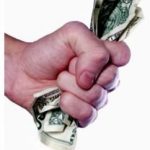When I was a little kid in the early 1950?s, my grandfather used to endlessly rail against Franklin Delano Roosevelt. The WWI veteran, who was mustard gassed in the trenches of France and was a lifetime, died in the wool Republican, said the former president was a dictator and a traitor to his class, who trampled the constitution with complete disregard. Hoover, Landon, and Dewey would have done much better jobs.
What was worse, FDR had run up such enormous debts during the Great Depression that not only my life would be ruined, so would my children?s lives. As a six year old, this disturbed me quite a lot, as it appeared that just out of diapers, my life was already pointless. Grandpa continued his ranting until a three pack a day Lucky Strike non-filter addiction finally killed him in 1977.
What my grandfather?s comments did do was spark in me a permanent interest in the government bond market, not only ours, but everyone else?s around the world. So what ever happened to the Roosevelt debt?
In short, it went to money heaven. And here I like to use the old movie analogy. Remember, when someone walks into a diner in those old black and white flicks? Check out the prices on the menu on the wall. It says ?Coffee: 5 cents, Hamburgers: 10 cents, Steak: 50 cents.?
That is where the Roosevelt debt went. By the time the 20 and 30 year Treasury bonds issued in the 1930?s came due, WWII, Korea, and Vietnam ?happened and the great inflation that followed. The purchasing power of the dollar cratered, falling roughly 90%, Coffee was now $1.00, a hamburger $2.00, and a Steak $10.00. The government, in effect, only had to pay back 10 cents on the dollar in terms of current purchasing power on whatever it borrowed in the thirties.
Who paid for this free lunch? Bond owners, who received, minimal, and often negative real, inflation adjusted returns on fixed income investments for three decades.
This is not a new thing. About 300 years ago, governments figured out there was easy money to be had by issuing paper money, borrowing massively, stimulating the local economy, and then repaying the debt in devalued currency. This is one of the main reasons why we have governments, and why they have grown so big. Unsurprisingly, France was the first, followed by England and every other major country.
The really fascinating thing about financial markets so far this year is that I see history repeating itself. Owners of bonds have had a terrible start, and things are about to get much worse.
The 30-year Treasury bond suffered a 3% loss in January. That means it has already lost its coupon for the year. Bondholders can expect to receive a long series of rude awakenings when they get their monthly statements. No wonder Bill Gross, the head of bond giant, PIMCO, says he expects to get ashes in his stocking for Christmas this year.
The scary thing is that we could be only six months into a new 30-year bear market for bonds that lasts all the way until 2042. This is certainly what the demographics are saying, which predicts an inflationary blow off in decades to come that could take Treasury yields to a nosebleed 18% high. That scenario has the leveraged short Treasury bond ETF (TBT), which has just leapt from $59 to $69, soaring all the way to $200.
Check out the chart below, and it is clear that the downtrend in long term Treasury bond yields going all the way back to April, 2011 is broken, and that we are now headed substantially up. The old resistance level at 1.95% now becomes support. That targets a new range for bonds of 1.90%-2.40%, possibly for the rest of 2013.
There is a lesson to be learned today from the demise of the Roosevelt debt. It tells us that the government should be borrowing as much as it can right now with the longest maturity possible at these ultra low interest rates, and spending it all.
If I were king of the world, I would borrow $5 trillion tomorrow and disburse it only in areas that create domestic US jobs. Not a penny should go to new social programs. Long-term capital investments should be the sole target. Here is my shopping list:
$1 trillion ? new Interstate freeway system
$1 trillion ? additional infrastructure repairs and maintenance
$1 trillion ? conversion of our transportation system to natural gas
$1 trillion ? construction of a rural broadband network
$1 trillion ? investment in R&D for everything
The projects above would create 5 million new jobs and end the present employment crisis. Who would pay for all of this? Today?s investors in government bonds, half of whom are foreigners, especially the Chinese and Japanese.
Whatever happened to my life? Was it ruined, as my grandfather predicted? Actually, I did pretty well, as did the rest of my generation, the baby boomers. My kids did OK too. Grandpa was always a better historian than a forecaster. But he did make a fortune in real estate, betting on the inflation that always follows borrowing binges.
Grandpa (Right) in 1916 Was a Better Historian Than Forecaster







